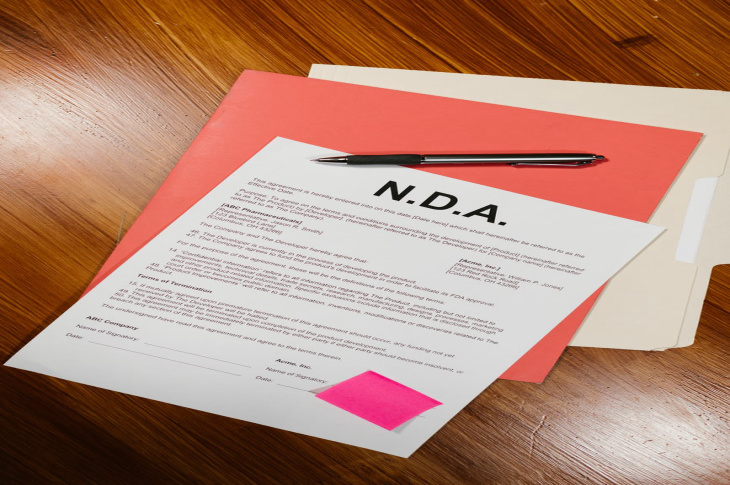Elements and Types of Non-Disclosure Agreements
What is a Non-Disclosure Agreement?
A non-disclosure agreement (‘NDA’) is a legally enforceable contract that creates a confidential connection between two parties. The signatory party or parties agree that any sensitive information they collect will not be shared with anyone else.
NDAs are common for businesses entering into negotiations with other businesses. They allow the parties to share sensitive information without fear that it will end up in the hands of competitors.
Key Elements of Non-Disclosure Agreements:
The Elements of an NDA are:
- “Confidential Information” must be defined: The definition of Confidential Information must be broad enough to encompass all types of information that falls within the topic. Under this topic, both tangible and intangible data might be included. Only information that is already in the public domain and already known to the Receiving Party can be considered secret.
- Term of the Agreement: The period of the Agreement must be specified; even if the Agreement is terminated, the confidentiality obligations can be maintained in the case of sensitive information, such as trade secrets, that are critical to a company's success. In general, the tenure should last between two and five years.
- Information’s Use: Some parties limit the dissemination of information to a small number of their workers or departments. In this clause, the phrase to consider is "need to know." In essence, this provision stipulates that the information provided should only be used for the purposes stated in the Agreement, and that it should only be shared with those who have a "need to know."
- Exceptions to secrecy obligations: Certain exceptions to the confidentiality duties must be included in an NDA. Information given during a legal process or a judicial inquiry, as well as information disclosed by a third party who has no duty of secrecy to the disclosing party, are examples of such exceptions.
- Return of information: Once the NDA's duration expires, the receiving party must return the information, together with any derivative information, and erase it from their operating systems.
- Remedies in case of breach: In the event of a breach, every NDA should have a clear clause saying that the aggrieved party shall have the right to act legally in a specific defined manner. In many situations, monetary compensation is insufficient, hence clauses relating to indemnification for the offended party and the right to seek an injunction have become quite popular.
- Arbitration: An arbitration clause specifies that the parties will settle their disagreements through arbitration rather than going to court.
- Jurisdiction and Governing Laws: Different parties may be from different countries, and the laws of different countries differ significantly. It is important to be specific and select the set of laws that will regulate the Agreement. Along with the set of governing statutes, the parties should select the city whose courts would have jurisdiction over any conflicts between them.
People Also Read This: What Is A Non-Compete Clause In An Employment Contract?
Types of NDAs:
NDA can be of three types:
- 1. Unilateral NDA-It involves two parties, but only one of them exposes sensitive information to the other and wishes to keep it private.
- 2. Bilateral NDA (Mutual NDA): This type of NDA is also called as Mutual NDA. It includes two people, each of whom discloses information to the other and intends to keep that knowledge from being disseminated further.
- 3. Multilateral NDA-It requires three or more parties to sign the agreement, with at least one-party disclosing information to others and intending to keep it from being spread further. Instead of having two or three unilateral or bilateral NDAs, a single Multilateral NDA might be used.
Confidential Disclosure Agreement:
The terms confidentiality agreement and NDA are sometimes used interchangeably, making it difficult to distinguish between the two. Each term can be found in a variety of commercial contexts, thus complicating the matter. A confidentiality agreement is a legal document that requires one or more parties to keep confidential/classified information hidden. A non-disclosure agreement is a legal document that requires one or more parties to keep confidential/classified information secret.
A secrecy clause is typically used when proprietary business information or a trade secret is not intended to be divulged to the public domain, other parties, or market competitors. An NDA is usually more appropriate when there is only one-way communication of classified information. A confidentiality agreement, on the other hand, is better suited for collaborations, such as when two or more parties are working on a project that necessitates the exchange of sensitive information or the production of intellectual property.
Proprietary Information Agreement:
A Proprietary Information Agreement is a legally enforceable contract that states that a number of parties must not divulge sensitive supplies, data, or information to a different third party as specified in the deal.
People Also Read This: How to Break a Non-Disclosure Agreement?
Secrecy Agreement:
A secrecy agreement, is a crucial contract that safeguards a company's trade secrets. It ensures that all employees, partners, suppliers, and other contractors understand the necessity of maintaining the confidentiality of any information they come across while working for the organisation.
All four terms (Secrecy Agreement, Confidentiality Disclosure Agreement, Proprietary Information Agreement, Non-disclosure Agreement) are used interchangeably and there isn’t a significant difference between them.
Trending



Ask a Lawyer